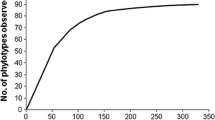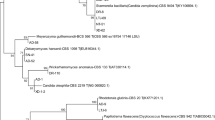Abstract
The yeast-26S rRNA libraries were constructed from two different fermented soybean foods, doenjang and kanjang. A total of 42 clones, containing the partial 26S rRNA sequences, 0.6 kb in length, were sequenced and subjected to an online similarity search. All doenjang yeast (DY) clones only appeared in the Saccharomycotina class. The 21 clones from the doenjang library were classified into five groups: Debaryomyces hansenii (DY I, 76.0 %), Zygosaccharomyces pseudorouxii (DY II, 9.6 %), Candida versatilis (DY III, 4.8 %), Candida etchellsii (DY IV, 4.8 %), and Debaryomyces castellii (DY V, 4.8 %). The 21 kanjang yeast (KY) clones were affiliated with the Saccharomycotina (52.4 %), Urediniomycetes (19.0 %), Ustilaginomycetes (23.8 %), and Hymenomycetes (4.8 %) classes and divided into six groups: D. hansenii (KY I, 38.0 %), Sterigmatomyces halophilus (KY II, 19.0 %), Malassezia restricta (KY III, 23.8 %), Cryptococcus magnus (KY V, 4.8 %), and Pichia triangularis (KY VI, 9.6 %). Yeast belonging to the Saccharomycotina class was predominant (76.2 %) in fermented soybean foods, doenjang and kanjang. These findings are of fundamental value for understanding the complexity of two different fermented soybean foods.


Similar content being viewed by others
References
Aidoo KE, Rob Nout MJ, Sarkar PK (2006) Occurrence and function of yeasts in Asian indigenous fermented foods. FEMS Yeast Res 6:30–39
Boekhout T (2005) Gut feeling for yeasts. Nature 434:449–451
Bolumar T, Sanz Y, Aristoy MC, Toldrá F (2003) Purification and properties of an arginyl aminopeptidase from Debaryomyces hansenii. Int J Food Microbiol 86:141–151
Bolumar T, Sanz Y, Aristoy MC, Toldrá F (2008) Purification and characterization of protease A and D from Deharyomyces hansenii. Int J Food Microbiol 124:135–141
Borneman J, Hartin RJ (2000) PCR primers that amplify fungal rRNA genes from environmental samples. Appl Environ Microbiol 66:4356–4360
Bovo B, Andrighetto C, Crlot M, Corich V, Lombardi A, Giacomini A (2009) Yeast population dynamics during pilot-scale storage of grape marcs for the production of Grappa, a traditional Italian alcoholic beverage. Int J Food Microbiol 129:221–228
Cabrera-Orefice A, Guerrero-Cstillo S, Luévano-Martínez LA, Peña A, Uribe-Carvajal S (2010) Mitochondria from the slat-tolerant yeast Debaryomyces hansenii (halophilic organelles?). J Bioenerg Biomembr 42:11–19
Callon C, Delbè C, Duthoit F, Montel MC (2006) Application of SSCP-PCR fingerprinting to profile the yeast community in raw milk Salers cheeses. Syst Appl Microbiol 29:172–180
Callon C, Duthoit F, Delbès C, Ferrand M, Le Frileux Y, De Crémoux R, Montel MC (2007) Stability of microbial communities in goat milk during a lactation year: molecular approaches. Syst Appl Microbiol 30:547–560
Chao HF, Yen YF, Ku MSB (2009) Characterization of a salt-induced DhAHP, a gene coding for alkyl hydroperoxide reductase, from the extremely halophilic yeast Debaryomyces hansenii. BMC Microbiol 9:182–195
Cho KM, Seo WT (2007) Bacterial diversity in a Korean traditional soybean fermented foods (doenjang and ganjang) by 16S rRNA gene sequence analysis. Food Sci Biotechnol 16:320–324
Cho KM, Kwon EJ, Kim SK, Kambiranda DM, Math RK, Lee YH, Kim J, Yun HD, Kim H (2009) Fungal diversity in composting process of pig manure and mushroom cultural waste based on partial sequence of large subunit r RNA. J Microbiol Biotechnol 19:743–748
Choi HS, Kim MK, Kim MK, Park HS, Song GS, Lee KK, Kim TY, Kim JG (2005) An approach to increase vitamin D2 level in doenjang (fermented soybean paste) using mushrooms. Food Sci Biotechnol 14:828–831
Cocolin L, Urso R, Rantsiou K, Cantoni C, Comi G (2006) Dymaics and characterization of yeasts during natural fermentation of Italian sausages. FEMS Yeast Res 6:692–701
Coignard C, Hurst SF, Benjamin LE, Brandt ME, Warnock DW, Morrison CJ (2004) Resolution of discrepant results for Candida species identification by using DNA probes. J Clin Microbiol 42:858–861
de Llanos FR, Fernández-Espinar MT, Querol A (2004) Identification of species of the genus Candida by analysis of the 5.8S rRNA gene and the two ribosomal internal transcribed spacers. Antonie Van Leeuwenhoek 85:175–185
Fell JW, Boekhout T, Fonseca A, Scorzetti G, Statzell-Tallman A (2000) Biodversity and systematic of basidiomycetous yeasts as determined by large-subunit rDNA D1/D2 domain sequence analysis. Int J Syst Evol Microbiol 50:1351–1371
Gordon JL, Wolfe KH (2008) Recent allopolyloid origin of Zygosaccharomyces rouxii strain ATCC 42981. Yeast 25:449–456
Harrison E, Muir A, Stratford M, Wheals A (2011) Species-specific PCR primers for the rapid identification of yeast of the genus Zygosaccharomyces. FEMS Yeast Res 11:356–365
Hernan-Gomez S, Espinosa JC, Ubeda JF (2000) Characterization of wine yeasts by temperature gradient gel electrophoresis (TGGE). FEMS Microbiol Lett 193:45–50
Jo GY, Lee CW (1997) Isolation and identification of the fungi from nuruk. J Korean Soc Food Sci Nutr 26:759–766
Jung KO, Park SY, Park KY (2006) Longer aging time increases the anticancer and antimetastatic properties of doenjang. Nutrition 22:539–545
Kim HJ, Lee EJ, Shin OS, Ji WD, Choi MR, Kim JK (1996) Volatile components in the soy sauce manufactured by Bacillus species and fused yeast. J Microbiol Biotechnol 6:194–201
Kim NY, Song EJ, Kwon DY, Kim HP, Heo MY (2008) Antioxidant and antigenotoxic activities of Korean fermented soybean. Food Chem Toxicol 46:1184–1189
Kim TW, Lee JH, Kim SE, Park MH, Chang HC, Kim HY (2009) Analysis of microbial communities in doenjang, a Korean fermented soybean paste, using nested PCR-denaturing gradient gel electrophoresis. Int J Food Microbiol 131:265–271
Ko JH, Lee YW, Choe YB, Ahn KJ (2011) Epidemiologic study of Malassezia yeasts in patients with Malassezia folliculitis by 26S rDNA PCR-RFLP analysis. Ann Dermatol 23:177–184
Kurtzman CP, Robnett (1998) Identification and phylogeny of ascomycetous yeasts from analysis of nuclear large subunit (26S) ribosomal DNA partial sequences. Antonie Van Leeuwenhoek 73:331–371
Lee TS, Lee SK (1970) Studies on the yeasts for the brewing of soy sauce (1). J Korean Agric Chem Soc 13:97–103
Lee TS, Lee SK, Shin BK (1970) Studies on the yeasts for the brewing of soy sauce (2). J Korean Agric Chem Soc 13:171–180
Lee YW, Byun HJ, Kim BJ, Kim DH, Lim YY, Lee JW, Kim MN, Kim D, Chun YJ, Mun SK, Kim CW, Kim SE, Hwang JS (2011) Distribution of Malassezia species on the scalp in Korean seborrheic dermatitis patients. Ann Dermatol 23:156–161
Lee JH, Lee BW, Kim B, Kim HT, Ko JM, Baek IY, Seo WT, Kang YM, Cho KM (2013) Changes in phenolic compounds (Isoflavones and phenolic acids) and antioxidant properties in high-protein soybean (Glycine max L., cv. Saedanbaek) for different roasting conditions. J Korean Soc Appl Biol Chem 56:605–612
Lim SY, Rhee SH, Park YY, Yun HS, Lee WH (2004) Inhibitory effect of methanol extracts and solvent fractions from doenjang on mutagenicity using in vitro SOS chromotest and in vivo Drosophila mutagenic system. J Korean Soc Food Sci Nutr 33:1432
Maidak BL, Cole JR, Lilburn TG Jr, Parker CT, Saxman PR, Stredwick JM (2000) The RDP (Ribosomal data-base project) continues. Nucleic Acids Res 28:173–174
Maqueda M, Zamora E, Rodríguez-Cousiño N, Ramírez M (2010) Wine yeast molecular typing using a simplified method for simultaneously extracting mtDNA, nuclear DNA and virus dsRNA. Food Microbiol 27:205–209
Maro ED, Ercolini D, Salvatore C (2007) Yeast dynamics during spontaneous wine fermentation of the Catalanesca grape. Int J Food Microbiol 117:201–210
McGinnis S, Madden TL (2004) BLAST: at the core of a powerful and diverse set of sequence analysis tools. Nucleic Acids Res 32:20–25
Petersen KM, Moller PL, Jespersen L (2001) DNA typing methods for differentiation of Debaryomyces hansenii strains and other yeasts related to surface ripened cheese. Int J Food Microbiol 69:11–24
Ragon M, Neugnot-Roux V, Chemardin P, Moulin G, Boze H (2008) Molecular gene cloning and overexpression of the phytase from Debaryomyces castellii CBS 2923. Protein Expr Purif 58:275–283
Saitou N, Nei M (1997) The neighbor-joining method: a new method for reconstructing phylogenetic trees. Mol Biol Evol 4:406–425
Shin EC, Kim YK, Lim WJ, Hong SY, An CL, Kim EJ, Cho KM, Choi BR, An JM, Kang JM, Jeong YJ, Kim H, Yun HD (2004) Phylogenetic analysis of yeast in the rumen contents of cattle based on the 26S rDNA sequence. J Agric Sci 142:603–611
Suezawa Y, Kimura I, Inoue M, Gohda N, Suzuki M (2006) Identification and typing of miso and soy sauce fermentation yeasts, Candida etchellsii and C. versatilis, based on sequence analyses of the D1D2 domain of the 26S ribosomal RNA gene, and the region of internal transcribed spacer 1, 5.8S ribosomal RNA gene and internal transcribed spacer 2. Biosci Biotechnol Biochem 70:348–354
Thompson JD, Higgins DG, Gibson TJ (1994) CLUSTALW: improving the sensitivity of progressive multiple sequence alignment through sequence weighting, position specific gap penalties sequence and weight matrix choice. Nucleic Acids Res 22:4673–4680
Tiquia SM (2005) Microbiological parameters as indicators of compost maturity. J Appl Microbiol 99:109–119
Wang QM, Li J, Wang SA, Bai FY (2008) Rapid differentiation of phenotypically similar yeast species by single-strand conformation polymorphism analysis of ribosomal DNA. Appl Environ Microbiol 74:2604–2611
Watanabe Y, Nagayama K, Tamai Y (2008) Expression of glycerol 3-phosphate dehydrogenase gene (CvGPDI) in salt-tolerant yeast Candida versatilis is stimulated by high concentrations of NaCl. Yeast 25:107–116
Xu B, Chang SKC (2011) Reduction of antiproliferative capacities, cell-based antioxidant capacities and phytochemical contents of common beans and soybeans upon thermal processing. Food Chem 129:974–981
Acknowledgements
This research was supported by Basic Science Research Program through the National Research Foundation of Korea (NRF) funded by the Ministry of Education, Science and Technology (Grant number 2010-0022508) and a Grant (No. 08-C2-15-002) from the Academic-industrial Cooperative Research Program of the Small & Medium Business Administration (SMBA), Republic of Korea.
Author information
Authors and Affiliations
Corresponding author
Rights and permissions
About this article
Cite this article
Haque, M.A., Seo, W.T., Hwang, C.E. et al. Culture-independent analysis of yeast diversity in Korean traditional fermented soybean foods (doenjang and kanjang) based on 26S rRNA sequence. J Korean Soc Appl Biol Chem 58, 377–385 (2015). https://doi.org/10.1007/s13765-015-0030-1
Received:
Accepted:
Published:
Issue Date:
DOI: https://doi.org/10.1007/s13765-015-0030-1




